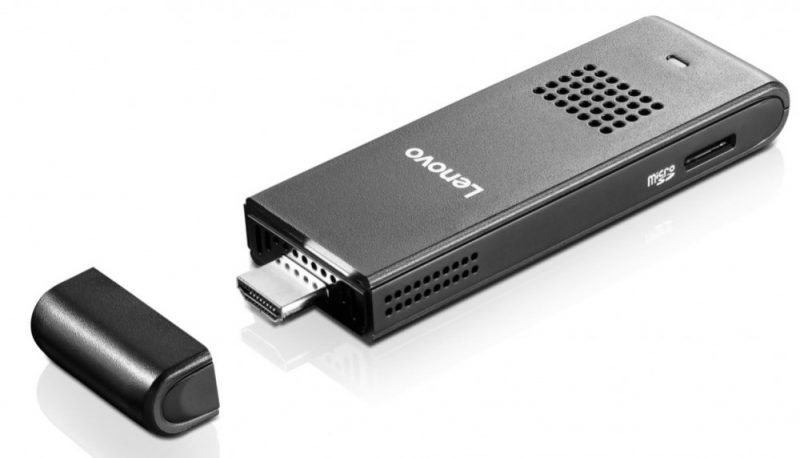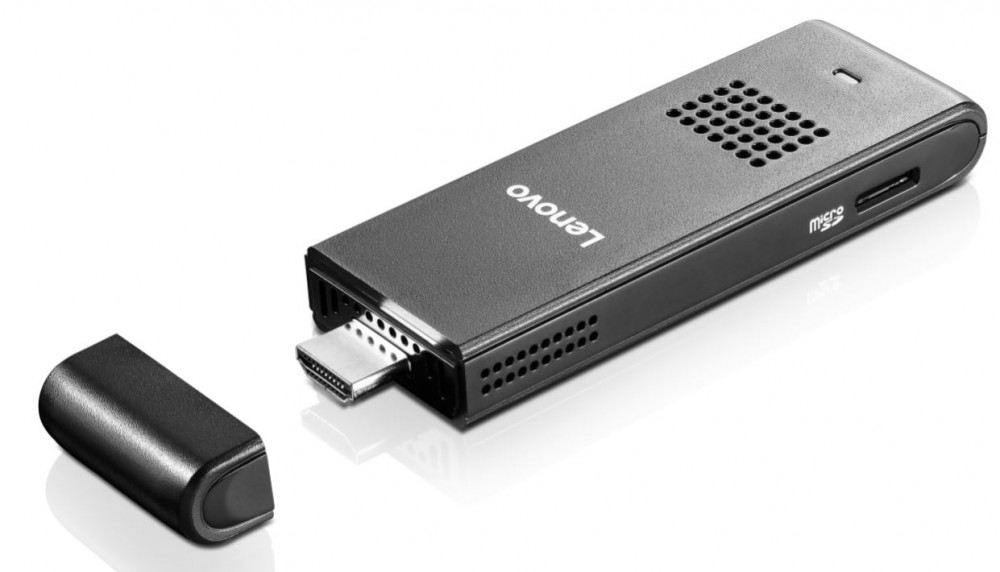Lenovo Ideacentre Stick 300


Lenovo’s Ideacentre Stick 300 is a ‘PC on a stick’ that will turn any screen with an HDMI port into a functioning Windows 10 computer. It’s small, portable, not too expensive at £99 (inc. VAT), and it works. Of course it doesn’t let you do everything a desktop PC or laptop would — but is it a useful travelling companion?
Lenovo isn’t the only company that thinks this concept has a market — there’s also Intel’s Compute Stick, Hanspree’s Micro PC, the ASUS/Google Chromebit CS10, Archos’sPC Stick, and more.
The Ideacentre Stick 300 doesn’t have an internal battery, and so needs a power connection. You’ll also need a mouse and keyboard. The stick has a single USB port, which works perfectly with a wired mouse and keyboard through a splitter. Or you can take a more ergonomic wireless route via the integrated Bluetooth 4.0. For £129 (inc. VAT) Lenovo bundles the Ideacentre Stick 300 with its own Ultraslim Plus Wireless Keyboard and Mouse, which costs £39 standalone. There are, of course, plenty of other wireless keyboard/mouse solutions on the market.
 The 100mm x 38mm x 15mm Ideacentre Stick 300 won’t always connect directly to an HDMI port because of space restrictions, so Lenovo includes a 10cm extender cable. This isn’t hugely generous, and you may well need a longer cable. Lenovo also provides a small mounting bracket that sticks to a hard surface, into which the Ideacentre Stick 300 clips. You might want to use this if you plan to use the stick regularly with the same screen.
The 100mm x 38mm x 15mm Ideacentre Stick 300 won’t always connect directly to an HDMI port because of space restrictions, so Lenovo includes a 10cm extender cable. This isn’t hugely generous, and you may well need a longer cable. Lenovo also provides a small mounting bracket that sticks to a hard surface, into which the Ideacentre Stick 300 clips. You might want to use this if you plan to use the stick regularly with the same screen.
etting started once all the cables are set up is a breeze. Plug in, switch on, and Windows 10 Home boots. I had to fiddle with the aspect ratio of my TV to get Windows full-screen, and settled for the somewhat squished but usable 4:3. It’s not ideal, but it is workable. Obviously if your screen has finer controls you’ll get a better result.

With a 1.33-1.83GHz Intel Atom Z3735F processor and 2GB of RAM this is not a powerful PC. Nor is it brimming with internal storage — there’s just 32GB on-board, of which my sample had only 11.2GB free out of the box. That’s less than many mobile phones and doesn’t leave much room for apps and data. Also like many phones, there’s a MicroSD card slot for adding storage, and you also get access to Micosoft’s OneDrive via 2.4GHz 802.11b/g/n wi-fi. You can of course configure other cloud storage, and my USB splitter provided access to a 500GB hard drive.
The Ideacentre Stick 300 worked for me without a hitch, and proved its capability in facilitating the writing of this review. But it does require mouse, keyboard and power, as well as a free HDMI port, and it has limited processing power and storage capacity.
I can see how it might be useful as a permanent fixture in space- or budget-restricted situations such as a spare bedroom, but with all the bits you have to carry around to make it function it’s not necessarily a lighter or more portable choice than a laptop — although it’s certainly a less expensive one.










